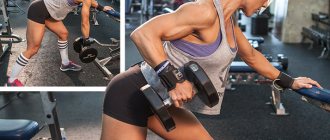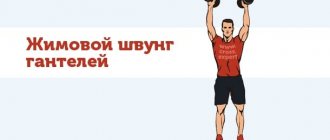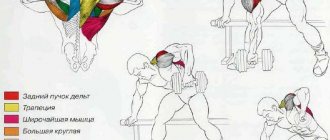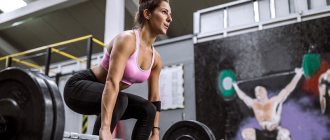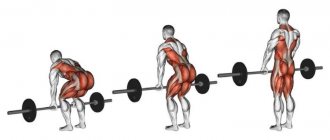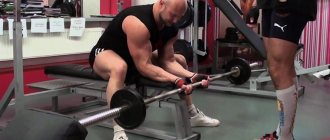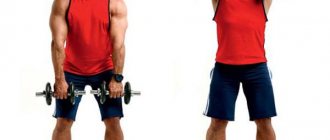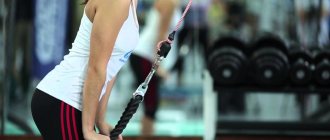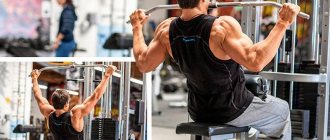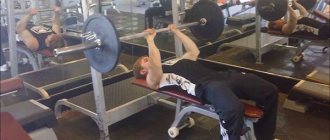The barbell behind-the-back row, or Lee Haney row, is perceived as an exercise for the rear delts, but was originally used to work the trapezius muscle in preparation for competition by eight-time Mr. Olympia Lee Haney. Hence the name of the exercise. The athlete himself used a barbell in the exercise, but today there are several variations - with dumbbells and in the Smith machine. Let's look at each option in more detail.
The benefits and harms of exercise
Should you do it? If you belong to the category of advanced amateurs or bodybuilding professionals, then it’s worth a try. If you are a beginner, then such a movement is of no use to you.
In general, as a beginner, stick to the simplest and most proven exercises!
Minuses:
- From an anatomical point of view, hyperextension of the shoulder is not natural for humans. Therefore, potentially dangerous.
- Not suitable for beginners due to difficult technique.
Pros:
- Works well on the rear deltoids and trapezius.
Contraindications
Invented by Lee Haney, the exercise is performed standing with a barbell or dumbbells. Moreover, the sports equipment is located behind the back. All this leads to an axial load on the spine.
In order for the bar to move freely along the buttocks and back of the thigh, you need to lean back slightly. Because of this, the load on the lower back increases.
Why am I telling this? And the spine and our shoulder girdle must be healthy, otherwise cravings should be avoided.
In particular, you should avoid it if you have diseases of the elbow and shoulder joints and osteochondrosis.
What muscles work?
We hope that in the previous section we were able to convince you of the benefits of such an exercise as the barbell row behind your back. And to completely dispel your doubts about whether you should include the exercise in your training program, carefully read which muscles work when performing barbell rows behind your back:
- middle and lower portions of trapezius muscles;
- deep-lying rhomboid muscles;
- posterior bundles of deltoid muscles;
- long bundles of the biceps muscles of the arms and brachioradialis muscles are indirectly involved.
© Makatserchyk — stock.adobe.com
Execution technique and exercise options
Deadlifts, just like shrugs, can be performed with a barbell, dumbbells or in a Smith machine. The last option differs from the version with a barbell only in that it makes it easier to maintain balance. Let's consider options with free weights.
With dumbbells
The advantage of dumbbells is that they allow you to increase your range of motion. In addition, there is no need to tilt the body back.
Now for the technique:
- Take dumbbells in your hands and stand up straight.
- Move your hands with the dumbbells back so that they are behind and slightly to the side of your buttocks. The grip should be straight, that is, the palms are facing back.
- Pull your shoulders back. Keeping your back straight, pull your elbows up. The shoulder girdle does not rise at this moment.
- When lifting your arms up, bend at the elbow joint. Pay attention to your forearms, they should remain perpendicular to the floor.
- Pull the barbell up until it is level with your lower back.
- Pause at the top for a couple of seconds, then return to the starting position.
The exercise can be modified by performing dumbbell rows first with one arm and then with the other. This, firstly, will increase the amplitude of movement, and secondly, it will allow you to concentrate more on the muscles being worked, which is useful when working on weight.
With a barbell
The technique with a barbell has minor differences from the version with dumbbells, as well as some disadvantages, for example, a more limited amplitude.
How to perform barbell deadlifts:
- If you can just sit down and pick up dumbbells, this trick won’t work with a barbell. Therefore, it must first be installed on the racks of the power frame just above the knees.
- Come with your back to it, squat down slightly and grab the bar with an overhand grip (palms facing back).
- Pull the barbell up to your lower back.
To reinforce the technique, watch a video about how pros perform deadlifts.
Classic (weightlifting) deadlift
The classic deadlift is the original and most versatile version of this exercise. It is in the classical deadlift, and not in the sumo deadlift, that the vast majority of world records are set (for example, this is exactly how the legendary Lamar Grant “pulled”8).
Technique for performing classic deadlifts:
- - Initial position.
Place your feet at shoulder width or narrower. Hand position is shoulder-width apart or wider. The shins almost touch the bar. The pelvis is set back, the back is arched at the lower back, the legs are bent at the knees. - – Failure and rise.
The lifting of the barbell from the floor is performed by pushing with the legs, and not by straightening the back (otherwise the spine can be damaged). Extension is the second phase of lifting, performed after a fall, simultaneously with straightening the legs at the knees and shifting the pelvis forward to a natural position. The bar moves straight up along the legs until they are completely straightened. - – Fixation.
Phase of maximum static voltage. Arms and legs are fully straightened, the bar is located in the middle of the thighs. As part of the training process, a fixation lasting up to 1 second is sufficient; on the platform, depending on the federation holding the competition, the fixation can be up to 3 seconds. - - Return.
All stalling and lifting movements are performed in reverse order. The legs are bent at the knees while the pelvis is pushed back (to prevent a critical load on the spine). The return is much faster than the stall and recovery. - - Nuances.
Throughout the exercise, look straight ahead, shoulders are pulled down and back, shoulder blades are brought together, arms are fully straightened. Any movement of the head or arms can cause injury.
As part of powerlifting, the classic deadlift is recommended for athletes with a short torso and long arms, which will minimize the range of motion of the bar. However, in this case, short fingers may be the limiting factor. To solve this problem, a special “lock” grip is used.
Example workout
The exercise can be adapted to suit any ability and can be performed even at home.
At home
If you have dumbbells or weights lying around in your closet, it’s simple. Perform the exercise in accordance with the recommendations already given.
Place deadlifts at the end of your back workout, as large muscle groups such as the lats and erector spinae should be worked first.
- Pull-ups on the bar - 3-4 sets of 12-6 repetitions.
- “Boat” - 3-4 sets of 15-10 repetitions.
- Deadlifts – 3-4 sets of 15-10 reps.
How to do deadlifts at home? Use either dumbbells or kettlebells, or a resistance band.
In the gym
In the gym you have all three types of weights at your disposal: dumbbells, a barbell and a Smith machine.
A set of exercises might look like this:
- Deadlift – 3-4 sets of 12-6 reps.
- Pull-ups – 3-4 sets of 12-6 reps.
- Smith rows – 3-4 sets of 15-10 reps.
In all exercises, strictly follow the technique!
Lee Haney Deadlift
The principle of execution is the same as that of shrugs, only the bar is located at the back. Lee Haney explained this exercise this way: the trapezius is located at the back, so it is necessary to pump them in this way. You can do the Lee Haney Row as a single exercise for the neck muscles or in addition to shrugs. I advise you to do the same once every 15 times in 3 approaches.
That's all. By doing these exercises once a week you will have a beautiful neck that will make you stand out from the crowd. It is also better to pump the trapezius after pumping the back, for example after deadlifting.
Tips for implementation
Sets and reps
Since the exercise in question is not natural for a person, I advise using less weight and more repetitions - 10-15. For building muscle mass, this will be no less effective than 6-8 repetitions. As for the approaches, everything is standard here, 3-4 will be more than enough to work the trapezius and rear delts.
What weight to take
As I already said, there is no need for a lot of weight here. Choose a weight that will allow you to perform the exercise with perfect form for 15 repetitions. When the weight becomes so light for you that in 3-4 working approaches you can overcome 11-12 repetitions, throw a couple of kilograms on the barbell.
Equipment
To provide greater stability to the lumbar region, use a weightlifting belt for the final working sets.
In many pulling exercises, where the weight is held using grip strength, part of the attention involuntarily shifts to the muscles of the forearms and arms. To avoid this, use loops or wrist straps.
Which grip is better - narrow or wide?
Bent-over barbell rows can be performed with a wide or narrow grip. In the first case, the emphasis of the exercise is on the upper back (trapezius, rhomboids and lateral deltoids), while with a narrow grip the middle back and lats work better.
The type of grip can also vary - palm on top or bottom of the barbell. According to research, an open palm position increases the load on the biceps and latissimus muscles, while the reverse position (palm facing down) places greater emphasis on the trapezius.
Most often it is recommended to alternate variations of the exercise. Or, in the case of training focusing on a specific muscle group, choose the one that fits better with your current program.
***
Bent-over barbell rows are one of the best exercises for developing the latissimus muscles, as well as for giving the back a characteristic “thickness” (when viewed from the side). Proper technique requires a fairly strong forward lean and the ability to maintain a conscious tension in the body.
Illustrations:
- The Ultimate Guide On How To Do Barbell Rows To Build A Bigger Back, source
Common mistakes
While in the gym, I often notice how guys try to lift as much weight as possible in an exercise. In doing so, they make typical mistakes:
- The lower back and thoracic spine are bent.
- They try to raise their elbows high. While the range of the shoulder joint in this part of the trajectory is limited.
- Engage your biceps, trying to pull the barbell as close to your lower back as possible.
- They use cheating, adding footwork.
- Raise your shoulders up, as when performing a shrug.
By violating the technique in this way, you may be able to handle more weight, but in return you may get injured!
Common mistakes in bent over rows
Error in back position
The back should be in a comfortable arbitrary position.
The back should be straight and the lower back arched to maintain proper technique.
Cheating
Try to help your back while lifting the barbell to lift the weight.
Perform the exercise in a stationary position. Your back should be in one position. Only a slight downward bend is allowed to better stretch the latissimus muscles.
Knee position
Knees should be straight.
The knees are always bent. This will allow you to not lose the deflection in your lower back at the bottom point.
